The following accounts of field operations are the best efforts of the newsletter editor, are NOT official reports, and may have errors and omissions, for which apologies and regrets are expressed in advance.
January
January 2, 1997 97-01R. Swift water rescue at Mountaingate Lodge in Walker Canyon. During a major winter storm (100 yr. flood), a husband and wife from Gardnerville with their 18 month old child were stranded by the flooding West Walker River in a cabin to the rear of the Mountaingate Lodge. The river had jumped its banks and was flowing swiftly between the cabin and Hwy. 395, thus isolating the trio. Team personnel responded with difficulty as Hwy 395 in Walker Canyon was closed due to washout. Only Dean Rosnau got through on 395; others had to detour to Topaz via 182, and many responders were never able to get to the scene at all. MWTC personnel on scene assisted with unsuccessful attempts to rescue the trio. Longhorn helicopter from NAS Fallon arrived at 1525 and extracted rescuers from a rubber raft, then the Gardnerville trio, and lastly two rescuers from a roof. This operation was the main subject of the January meeting, with video, and many more thrilling and impressive details were revealed. It is amazing that no lives were lost. It was close. Records are not complete, but responders (who at least attempted to go) were: Moats (Ops), Biederman, Burns, Rosnau, Browne, Case, DeGeorge, Enyeart, Estridge, Ford, Lee Frees, Frey, Glenn, Gilbreath, Guenther, Harvey, Lewis, McBride, Cumpston, McCabe, White, and Wright.
See Rescue at Mountain Gate: The Walker River Flood of 1997 for a detailed account by Dean Rosnau.
January 15, 1997 97-??R. Overdue Snowmobiler, Deadman Creek. Husband and wife were taking turns with their snowmobile while the other cared for a child in the car. The wife was overdue in the darkness, and eventually found her way to the Crestview rest area, where she was found in the phone booth. cancelled before the callout was finished. Responders were: Feiner, Moats, Rosnau, Case, D. Frees, Gilbreath, Lewis, Nelson, T. Lefever and McCown.
January 24, 1997 97-02R. Missing Skier, Mammoth Mountain. After a B class lesson, Richard Cintron missed a turn onto Pumpkin and went down into a ditch. Unable to climb out, he continued down until trapped above cliffs above Lake Mary road in an avalanche zone. A passing motorist stopped to take a photo and heard his calls for help. Mammoth PD responded but due to steep snow and avalanche danger the SAR team was called out. A team led by Gary Guenther, with Dave Harvey, Kevin McBride and Glen Taylor reached the victim in 28 minutes, and took 86 minutes to get him down. He was not injured. Responders were the above, plus: Enright, Gilbreath, L. Frees, Soler, Hall, Rousek, DeGeorge, and Rosnau.
The installation and dedication of the cast bronze memorial plaque that Doug Nidever and Dean Rosnau obtained to honor and commemorate our teammate Pete Schoerner will be held Wednesday January 29, 1997, exactly one year from Pete's fall while climbing ice on Carson Peak. Meet at the June Lake Power Plant at 1030 for the hike to the base of the wall. The dedication will start at 1145.
The memorial plaque for Pete Schoerner could not be placed below the wall due to avalanche danger on January 29, but the ceremony was held below on the road. Most of the funding came from team members' donations, and left a surplus to go to the fund for the children. If you want to go to the wall when the plaque will be placed when weather permits, contact Dean Rosnau.
Also, on the same day, there will be a special ceremony dedicating the Pete Schoerner Trauma Room at Mammoth Hospital, in memory of Pete and his contributions to the Paramedic Program, Hospital, Search and Rescue Team, and Fire Department.
January 31, 1997 97-??R. Missing man. A man who went for a walk on Wednesday, possibly to the Sparkplug mine, was reported missing on Friday. Tim Lefever responded, but the man was found shortly after in Huntington Beach. cancelled.
The Qualifications Committee met in December and reviewed all the team's Candidate Members. Four Candidates were found to have completed training or demonstrated proficiency in all steps of the ladder to Rescue Membership. At the January meeting, the team voted to accept these four as Rescue Members. Congratulations are due to Jim Endo, Bruce Enyeart, Dave Harvey, and Dean Rosnau.
Following his elevation to Rescue Member at the January meeting, Dave Harvey was duly nominated and elected to be the team Secretary. Many thanks are due to Ross Biederman who served in the interim period.
February
February 3, 1997 97-??R. Fallen Ice Climber, Lee Vining Canyon. Eric Easton was solo ice climbing when he fell, ripping out the top 3 ice screws and hooking a crampon and sustaining a multiple fracture of the left ankle. Duane Evans, a climbing guide, with help from his paramedic client and other climbers present got him down, splinted his leg, rigged a makeshift litter, and carried him out to the Poole Plant, where Medic 2 transported him to Mammoth. The mission went cancelled before our team arrived. Known responders were: Rosnau, Harvey, Lewis, and White.
February 4, 1997 - Avalanche Awareness Training and videos with Gary Guenther at team meeting.
February 10, 1997 - Ice Climbing Training with Doug Nidever and Dean Rosnau. Meet at the Poole Power Plant off the Tioga Pass road at 0830.
February 12, 1997 - Backcountry and Telemark Sking Training with Win Lee Lewis and Chuck Curtis at June Mountain Ski Area. Telemark instruction and practice for all levels (even beginner) plus some backcountry travel. Bring your gear, and ten bucks for lift ticket. Great opportunity to learn from real experts. Meet at the top of Chair 1 at 10 AM.
February 25, 1997 - Avalanche information, probe practice, Tele Skiing, search dog demonstration, off-piste tour Training with Eric Diem and Sallee Burns. Bring skis and other gear. Lift tickets will probably be complimentary. 9 AM
Welcome to new Candidates Charlie Curtis and Scott Hermann, who were accepted at the February meeting.
Attaboy to Pete DeGeorge for the new lettering on the Rescue vehicles. Kevin McBride helped too.
March
March 2, 1997 97-??R. Missing Skier, Mammoth Mountain Vicinity. The subject was reported overdue when he did not check in with family the evening of March 1. His car was found near Chair 2, and his room at Tamarack had not been used by the following morning. Following a team callout with excellent response, he returned under his own power, having had a boot or binding problem, and spending the night at the Red Cones. Those known to be responding were: Biederman, Burns, Clayton, Feiner, L. Frees, Rosnau, Aguirre, Curtis, DeGeorge, Guenther, Harvey, Hermann, Lewis, McBride, White, Wright, Gilbreath, T. Lefever, McCown, and Rousek.
March 3, 1997 - Snowmobile Training with Don Little at Smokey Bear Flat
March 4, 1997 - CPR Training with Dr. Ross Biederman at team meeting at June Lake Community Center.
March 7, 8, 9, 1997 - Swiftwater SRT-1 Course by University of Nevada Reno at Reno/Truckee River.
March 13, 1997 - Ice Climbing Training and practice with Doug Nidever and Dean Rosnau at Poole Power Plant off the Tioga Pass road at 0830.
March 24, 1997. Mutual aid to Inyo team. Search for Jim Williams, who is believed to have been unable to get out of the Aqueduct after jumping in to rescue his dog. Water level in the aqueduct and the channel was high and very turbulent. Bank and boat searches and grappling results were negative.Responders were: Dean Rosnau, Dave Harvey, Tim LeFever, Karen McCown, and Joe Rousek.
See also continuation of search on March 27, 1997
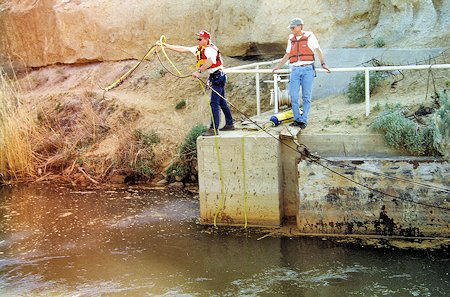
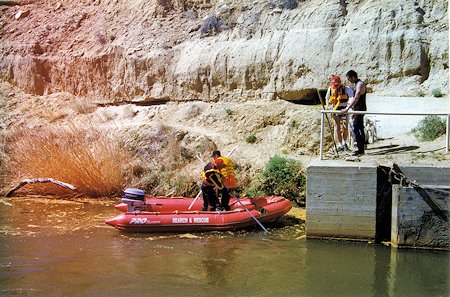
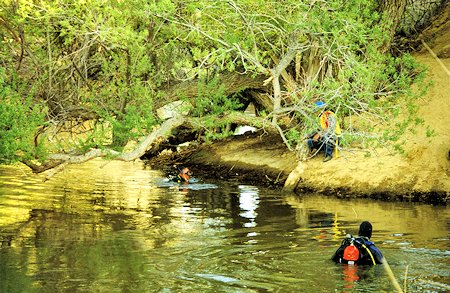
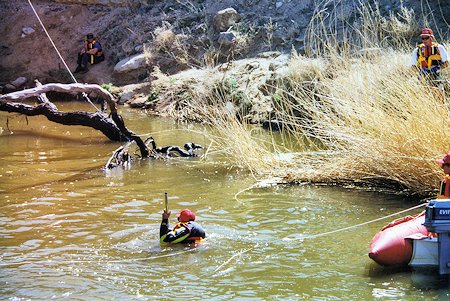
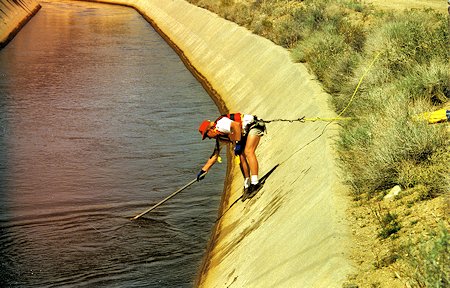
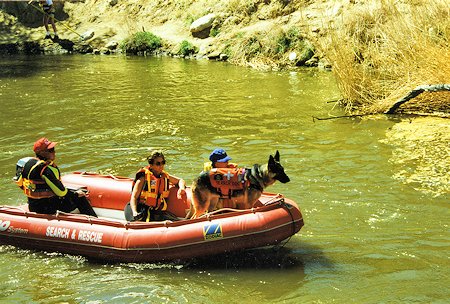
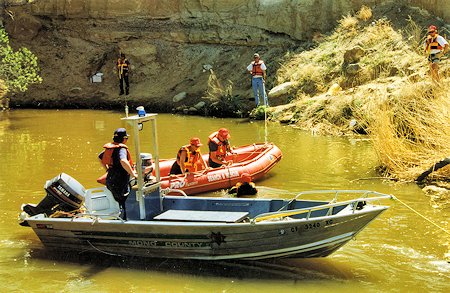
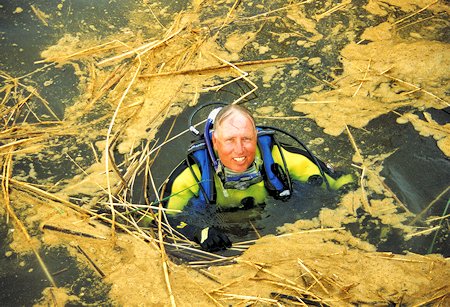
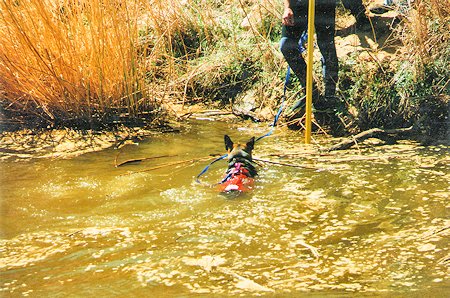
March 26, 1997. Ice Climbing in Lee Vining Canyon with Doug Nidever
From Review-Herald newspaper report by Karen Riggs:
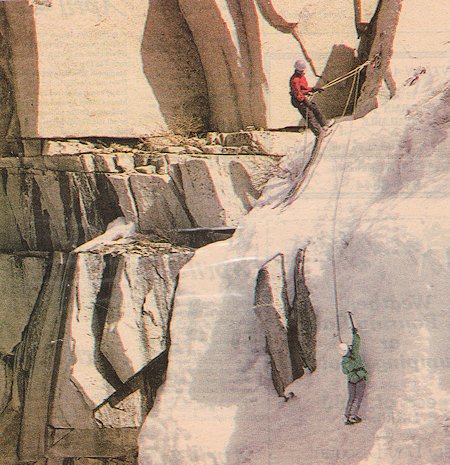
Ice Climbing In Lee Vining Canyon
Ice Climbing in Lee Vining Canyon Up the steeps of Lee Vining Canyon, blue ice keeps company with the vertical slabs of granite. Blue and green ice are mana to climbers who ascend these gigantic icicles.
But ice changes with weather, and constant evaluation and reevaluation of conditions are required for safety, according to Doug Nidever, mountain guide for Alpine Skills International and Yosemite Mountaineering School.
White ice tends to be rotten, not the kind of medium that will hold an ice axe solidly, with a climber attached, Nidever said.
A climber since 1968, Nidever said a major part of his job is the constant judgments and error corrections which he makes in order to keep his clients safe. "You have to be looking all the time, trying to stay ahead of things," he said.
Lee Vining Canyon is prime avalanche territory. Due to weather conditions, Nidever said he aborted a couple of trips, before even ascending into the canyon this year.
But, he also said, local climbers agree ice climbing was better this year than any in their collective memories. The rain event in January made ice falls on walls where they had never seen them before.
A warm March, with no additional moisture, is closing the ice climbing season. On March 26, Nidever pointed out cracks forming across the main wall, then steered us to the smaller wall. "You do everything you can to increase your safety margin," he said.
Climbers ascend ice for a variety of reasons, according to Nidever. "People often make the progression from rock to snow to ice climbing." For himself, he likes the complete picture of mountaineering. (Mountaineering is technical climbing, which in a fall without ropes, a climber would most likely die.) "You can go just about anywhere you want, in every imaginable condition."
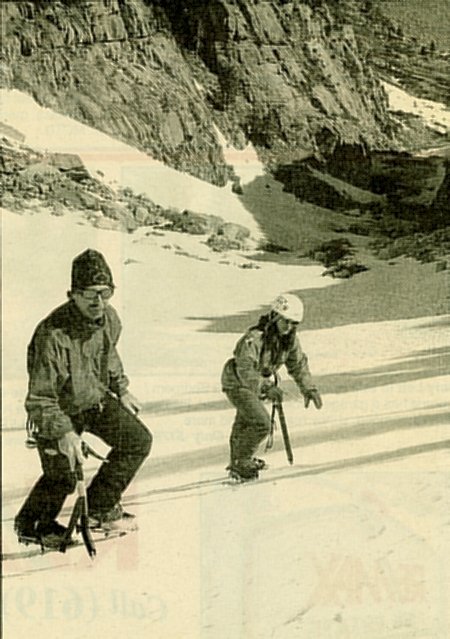
Doug and Sharon Nidever are climbing companions, as well as husband and wife
Review-Heralds/Karen Riggs
The most difficult part of his job, he said, is matching a client's ability, motivation and desire with a correct route choice. "You have to be able to read between the lines."
He said climbing is a great way to spend time together with people. His wife Sharon, and their sons Tobin, 11, and Layton, 9, are also outdoor adventurers.
Ice climbing has similarities to rock climbing with some notable differences. Ice climbing is "equipment dependent." With rock climbing, it's basically between a person and a rock: shoes aren't even essential.
Because of the cold, ice climbers need extreme gear for warmth. " I try to stay ahead of the cold," Nidever said. After slogging up the canyon, sweat quickly turns cold in the shade of the northern facing ice falls.
Rock climbers use their bare hands to hold natural features of the rock. While ice climbers also make use of natural features (protrusions and depressions), they are not dependent on them. "You make holds wherever you want," Nidever said.
With an ice axe in each hand (or a single axe) and crampons on their boots, the climber has a lot of sharp points to fix into the ice. "The axes have straps on the handles, adjusted so the body weight rests on the wrists, not on the handle grip.
As in rock climbing, the legs do most of the work. "No one can do pull-ups all day," Ni lever said. Crampons have spikes pointing out from the toes, as well as on the soles. The toe spikes get most of the action in vertical terrain. Small steps are taken, by kicking the toes into the ice, ascending little by little.
The ice axes are inserted at a full arm's length, and then the feet work up. With "user friendly" ice, the axes stick on the first or second thrust. But, sometimes, "dinner plates" come flying off, which is why climbers wear helmets.
Nidever said ice climbing is basically a "no fall activity." As in sport rock climbing, ropes are secured by bolts on the rock (screws for ice) and used as backup in case of a fall.
But, because of all the sharp instruments on an ice climber, "it's just too dangerous to fall," Nidever said. Broken ankles are the most common injury for ice climbers, he said. It can occur when a climber falls, and his or her crampons catch the ice and snaps the ankle.
A fall in rock climbing, backed up by ropes, can be considered beneficial for pushing the outer limits of a person's skill level.
When people go ice climbing they should know the hazards, Nidever said. "Just like a person who gets a driver's license, should know the potential dangers. The opportunity is very real to hurt yourself," Nidever said.
Nidever was belaying (at the other end of the safety rope) when long-time climber Pete Schoerner died in a climbing accident, Jan. 29, 1996. "When it comes up, I get mad at Pete, because if he had followed our plan, he'd still be here laughing and joking," Nidever said.
Schoerner changed plans on the fourth pitch (a pitch is generally a rope length of about 165 feet) of their way up a climb near Carson Peak. He attached his safety devices (an ice screw and a spectre hook) into the ice rather than into rock as was earlier agreed upon. The slab of ice Schoerner was attached to broke off and took him down.
Nidever could well have come down too. A complex set of circumstances kept him alive. Attached to rock with an anchor, about 60-70 feet of rope ran through Nidever's belay device, before the ice slab hit a rock protrusion and exploded, disconnecting Schoerner's screw and spectre hook from the ice. (Normally, a belay device will stop a person's fall with the other person's weight, but the weight of the ice slab was too heavy for the device to hold.)
Asked if he considered quitting after the accident, Nidever said, no. "It set me back a ways, but I didn't stop climbing. It never should have happened."
"There's no use worrying about Doug," his wife Sharon said, "It doesn't do any good, anyway, and I know Doug to be a very safe climber."
She must have absolute trust in him. On the day we went climbing, he brought her down more than 155 feet on his back, rappelling, in a practice rescue. "It's always an adventure being married to a mountain guide," she said.
March 27, 1997. Continuation of the Jim Williams search. The water level had been lowered significantly. Key spots in the lake, and the channel between the aqueduct and the lake was searched from land and boat with 3 search dogs, grappling hooks, poles, and some diving by Tim and John. The dogs alerted strongly just below the end of the concrete, but results were negative. Responders were: Dean Rosnau, Tim Lefever, Karen McCown, John Estridge, Jim Gilbreath, Brent Kennedy, Bruce Enyeart, Gus Roderick, and Charlie Curtis.
March 28, 1997 97-03R. Missing Skier, Mammoth Mountain. Sheldon Siskin, age 70, failed to take a right turn toward chair 14 while skiing with a friend, and continued on downhill and downwater until he reached the cliffs below lower Rainbow Falls. MMSA ski patrollers searched Turkey Gulch and Fresno Bowl, and followed tracks past the pack station, then came back via snowmobile. 911 called at 1720. Little and Estridge went in on County snowmobiles, followed by four teams of two in a Mammoth Mountain snowcat. Three teams of skiers/snowshoers searched the area. At 0031 the team of Kevin McBride and Pete DeGeorge found the subject, alive, oriented, alert, tired, and a little cold. At 0545 the subject and all teams were out. Responders were: Sallee Burns, Win Lee Lewis, Kevin McBride, Pete DeGeorge, Ray Glenn, Bruce Enyeart, Don Little, John Estridge, Jim Gilbreath (ops), Leah Hall, Allan Weidner, and Brent Kennedy.
From newspaper report:
Skiers Rescued out of Bounds - Two skiers learned the hard way that as inviting as the backside of Mammoth Mountain may seem, there really is no way out -without the assistance of search and rescue authorities.
Cole Hampton of the Mono County Sheriff's Department reported that search and rescue services were required twice over the Easter weekend, luckily with good results both times.
At 5 p.m. Friday, March 28, the Sheriff's Department received a call from Ski Patrol at Mammoth Mountain Ski Area, requesting assistance in the search for 70-year-old Shelton Sisken. Sisken was last seen skiing off the back of the mountain around 1:30 p.m.
A search was started, using a snowcat from MMSA, and Sisken was found, safe and sound, just after midnight below the Rainbow Falls area.
Thank You letter from Shelton Siskin:
Dear Lady, Gentlemen and Dog,
Thank You, Thank You, Thank You. With great appreciation to the brave strong totally professional men from search and rescue, your calls were one of the most wonderful sounds that I have ever heard. My thanks also to the Ski Patrol and Trigger. Thank you for finding the trail and getting the rescue started in the right direction. The wonderful snowmobile drivers and the cat driver. Also my thanks to the people at Ski Patrol Headquarters who kept my wife informed that everything was going to be all right.
The good news is that there seem to be no aftereffects except for the memories, mostly good.
I hope that all of your future rescues turn out as well as this one did.
Thank You Again - The Victim - Shelly Siskin
March 30, 1997 97-04R. Missing Skier, Mammoth Mountain. Pete Huso skied off the back side of the mountain in the afternoon, but was alone, so it was not known if he was on the mountain or somewhere in town. Easter morning a search was started with team personnel, MMSA ski patrol, and Forest Service. Joe Rousek and Mark McNally (USFS) skied off the top, while Mark Daniel (USFS) and Deputy Jerry Hallum went in over Mammoth Pass on snowmobiles. Team member Bob Sollima went over Mammoth Pass on skis from Tamarack. Ski Patrol found the victim's campfire site near the falls. Bob Sollima and his dogs found the victim headed toward Mammoth Pass, and took him to Bob's cabin, from where he was evacuated by MMSA snowmobile. Good job Bob!. Responders were: Greg Enright (ops), Sallee Burns, Joe Rousek, Pete DeGeorge, Jim Gilbreath, Karen McCown, Tim LeFever, Scott Hermann, Victor Aguirre, Bruce Enyeart, and Bob Sollima.
From newspaper report:
(continued from above) - Hampton also said 32-year-old Peter Huso of Fontana was rescued Easter Sunday after spending the night on the backside of Mammoth Mountain.
Huso was skiing Saturday, March 29, when he went off the backside and was unable to get back out. Huso's girlfriend contacted the Mono County Sheriff's office Saturday evening when he failed to return and a search was initiated, using the resources of the MMSA Ski Patrol, plus a California Highway Patrol helicopter from Fresno.
Huso was found by searchers March 30 just after noon and was removed from the area by snowmobile. He was not injured during the overnight stay on the mountain.
Welcome to new Candidates Eloise Brown, Brent Kennedy, and Allan Weidner, who were accepted at the March meeting.
Congratulations to Dave Harvey, Dean Rosnau, Pete DeGeorge, and Bob Feiner, who were recently certified as Swiftwater Rescue Technicians at the UNR course at Reno/Truckee River. They reported having a wonderful time and learning a lot.
Donations for the memorial plaque for Pete Schoerner exceeded costs, and provided $610 to be given to the Schoerner children's fund.
April
April 1, 1997 - Basic First Aid Training with Dr. Ross Biederman at team meeting at Gilbreath home.
April 4, 1997 - Tracking Training with Greg Enright and Steve Case 6 PM at Rattlesnake curve on Conway grade.
April 6, 1997 - Orienteering and GPS Training with Jim Gilbreath at his home.April 10, 1997 97-05R. Overdue Subjects Chalk bluffs. Kurt Schultz and his two children failed to return from an afternoon drive. Subjects returned home the next day after the snow they had been stuck in hardened enough to drive out. Many roads had been searched by sheriffs deputies and family during the night. The team was called in the morning and Moats interviewed the RP, and Dean Rosnau searched many dirt roads.
April 19, 1997 - Hike to the summit of Glass Mountain with Greg Enright. Meet at 0900 at Rescue 3, or come to Sawmill Campground via Benton Crossing Road.
April 24, 1997 97-06R. Injured Skier, Rock Chute, Sherwin Range. Tim Schroeder and 5 friends were about to ski Rock Chute, and Tim was the first skier in the chute. He was side-slipping the top section when he fell on the hard-packed snow. He fell into rocks on the side of and below the chute. Rosnau, Case, and Luke Schwartkopf were the first to reach him, and Dave Harvey, Kevin Mc Bride and Pete DeGeorge brought up the breakaway litter. GPS was used to get Lat-Long for the CHP H-40 helicopter from Fresno. Rosnau and Mc Bride packaged Tim into Dean’s sleeping bag and began lowering. Lowering Techniques were employed by both teams for about 300 yards to a second LZ that was more suitable for loading Tim into the helo. Also responding were: Lee Frees (ops), Jim Endo (radio), Greg Enright, Sam LaLande, Natalie Nelson, Brant White, and others.
Welcome to new Candidate Jim Pyacek, who was accepted at the April meeting.
May
May 12, 1997 - Tracking Practice with Greg Enright. 6 PM at Shadyrest Trailhead Parking.
May 16, 1997 - Dive Training with John Estridge at Crowley Lake dock, 9am.
May 16, 1997 - Raising, Lowering, Ropes Training with Greg Enright and Don Little at Triple Cracks
May 19, 1997 - Search Training with Greg Enright and Don Little. Meet 6pm at Inyo Craters trailhead parking
May 24, 1997 97-07R. Glen Clark from Phoenix (and his dog) went on a day hike from Horseshoe Lake to Rainbow falls, and failed to return by morning. Dean Rosnau and Dave Harvey tracked him over Mammoth Pass to the falls, at which time he turned up at Mammoth Mountain Inn, having hiked out during the night and morning. He went downstream from the falls until discovering his error, then hiked something like 32 miles to get himself out. Tim and Karen picked him up at the Inn and brought him to search base. Responders were: Lee Frees (ops), Biederman, Enright, Case, McCown, Tim LeFever, Estridge, Gilbreath, DeGeorge, Rosnau, Harvey, Burns, and Aguirre. The county RACES team with Dave O'Hara, Kelly Lawrence, and Gus Roderick responded and set up communications.
May 24, 1997. Mutual aid to Inyo team. An OES request for mutual aid was made late in the day. Rosnau, Burns, and Harvey responded to North Lake to search for a missing juvenile, who turned up shortly thereafter.
June
June 9, 1997 - Ropes and Rigging Training, Part 1 with Greg Enright, at Howard Falls. Knots, rappelling, sound victim rescue. Meet at 5:30 PM on the road, about 1/8 mile below Twin Lakes outlet (Mammoth, not Bridgeport). Dress WARM, it's breezy there.
June 11, 1997 - RACES Indoctrination with Jim Gilbreath and Shawn Moats at Wispering Pines
June 16, 1997 - Ropes and Rigging Training, Part 2, with Greg Enright. 5:30 PM at Mammoth Rock. Low angle litter, knot passing, sound victim lowering.
June 21, 1997 - Dive Training with John Estridge at Convict Lake. 9 AM If you don't dive, come anyway, as help will be needed to aid the divers and do a shore search.
June 23, 1997 - Ropes and Rigging, Part 3, with Greg Enright. 5:30 PM at Triple Cracks. Litter packaging, litter attendant, litter raising.
June 27, 1997 97-08R. Chris Carlson became sick at Peeler Lake. Evacuated by Toiyabe helo. Handled entirely by Boe Turner.
June 30, 1997 97-09R. John Noyes overdue from Fish Creek. Subject located by trail crew at 1150, not really overdue. Responders were: Aguirre, Browne, Burns, DeGeorge, Gilbreath, Harvey, Rosnau.
June 30, 1997 97-10R. Jennifer Kelly Rescue, Iceberg Lake. Victim was a member of a 21-day Summit Adventures trip. On the 10th day she fell and slid down approximately 70 feet of ice and snow at the southwest corner of Iceberg Lake, suffering possible injuries of the neck, right thigh, knee, and hip. Trip members sheltered her in a tent on the lake peninsula. Weather delayed helo flights until afternoon. Dean Rosnau flew in with Rescue 6 from Fallon NAS while Dave Harvey and Win Lee Lewis hiked in from Agnew. Helo had to land near Lake Ediza due to steep snow around Iceberg Lake. Rosnau and Navy crew climbed up and packaged victim, while helo went back for fuel. Pilot Ann Wilson (same angel that picked Dean out of his tree in January) made a great landing on the peninsula after the tents were down, and extracted victim, crew, and Dean. Dave and Win had to hike out, as usual. Responders were: Rosnau, Aguirre, Harvey, Gilbreath, Burns, Lewis, Browne, DeGeorge, Little.
June 30, 1997 - Ropes and Rigging, Part 4, with Greg Enright. 5:30 PM at Mammoth Rock. Finale and Testing. Knots, harness, 3 to 1 raising system, lowering, belay, rappel, litter attendant, sound victim rescue.
Heartiest congratulations to Victor Aguirre, Pete DeGeorge, Tim LeFever, and Karen McCown, on the occasion of their elevation to Rescue Member at the June Meeting. It was a long route up the ladder, and we're all very pleased you did it.
Welcome to new Candidates Karen Riggs and Michelle Tracey, who were accepted at the June meeting.
July
July 1, 1997 - Van Training with Greg Enright at June Lake Community Center
July 4, 1997 97-11R. Stephen Ellinger fell to his death on slick and steep granite while backpacking with a friend above Saddlebag Lake near Conness Falls. Body recovery was done by Little, Case, Harvey, and Aguirre with the aid of boats across the lake and helicopter H40. Other responders were: Enright (ops), Moats, DeGeorge, Gilbreath, LaLande, McCabe, Burns, Estridge.
Here is Don Little's account of the operation: "When Steve and I arrived at the base of the falls Wilderness 1 pointed out our victim. Besides Wilderness 1 there was Anna and Scott (last names not known) from the resort, and Wilderness 13. The victim apparently fell 60-75 feet. No snow was involved. The rock was a very polished granite. The RP's pack weighed 50 lbs and the victims pack 30 lbs. Good hiking boots with good soles. Footing was very slippery due to the polished granite and very few cracks in the rock. Anna and Scott were the first to arrive on scene and started CPR. Anna said there was no pulse when she arrived. The victim slid head first down the first pitch (30 degrees) then hit a rock and was spun completely 180 degrees (Per RP). He then fell vertically for 50-60 feet and possibly hit on his right side. Large head contusion on right side of skull. Large amounts of body fluids on rocks around victims head and flowing down hill. Anna said the victim also had a broken arm and dislocated shoulder (right side). Victim was in the fetal position when found and was still wearing his pack. Anna and Scott had moved him to start CPR. By the time Steve and I arrived rigor mortis had set in and nothing would move. Right side of rib cage had large (10-12") cut. No blood was coming from cut but ribs were possibly broken. Both eyes were closed and very black. Possible broken neck (per Anna). Turned him on his side and looked at his back. The upper portion was purple with blood. All in all there were four pitches, first 30 degrees, second vertical, third 45 degree and fourth flat. While I took pictures and packaged the victim Steve was placing anchors and installing a safety line and a belay system. We packaged the victim and lowered him to the snow field below (20'). Dave Harvey and Victor Aguire climbed to the top of the cliff and Dave rappelled down to retrieve the RPs pack that was 60 feet above where the victim has come to rest. We then put the victim on a canvas stretcher Anna and Scott had and carried the victim to the LZ, 150 yards away. H40 departed at 5:45 pm."
July 7, 1997. 97-12R. Jeff Palmer became separated from his friends. He had nothing except a shirt and pants, and spent the night out. Dave Harvey and Joe Rousek flew in via Toiyabe helo. The victim was located soon after the helo took off, in good condition. Responders were: Moats (ops), Harvey, Rousek, Burns, Rosnau, Lewis, Aguirre, Gilbreath, LaLande, Wright, and RACES members Mike Clayton and Kelly Lawrence.
July 10, 1997 - Low Angle Litter Training with Don Little at Lower Rock Creek
July 14, 1997 97-13R. John Baker injured a leg in the King Creek area, but walked out before the search got started. Estridge was ops.
July 14, 1997 97-14R Mark Benson damaged a toe near Minaret Lake, but rode out on a horse before our valiant rescuers got to him. Responders were Rousek(ops), Rosnau, Harvey, LaLande, Enyeart, Estridge, Biederman, and Kennedy.
July 14, 1997 97-15R. Four kids from a YMCA group were injured below Rainbow Falls when they attempted to form a human chain to cross the river to aid another child trapped on a rock. The team was called to aid the Park Service rangers at 1830, and evacuated the four via litter. Responders were: Estridge(ops), Biederman, Roderick, Aguirre, Lee Frees, Kennedy, White, Rosnau, Lewis, Burns, Guenther, Enyeart, Harvey, Rousek, Browne, LaLande, and Sollima.
July 15, 1997 97-16R. Jessica Priest, 4 months pregnant, guiding clients for Rock Creek Pack station at Davis Lake, had severe abdominal pain in the night. Dean Rosnau and Lee Frees hiked in and transported the victim across the lake in a raft to an LZ, where H-20 helo picked her up. She underwent surgery for appendicitis that night, and is recovering just fine. Responders were: Gilbreath(ops), Tracey, Lewis, Harvey, Frees, Aguirre, Rosnau, Enyeart, LaLande, and Browne.
July 19, 1997 - Technical Rock and Rope Class, with Dean Rosnau, at TJ Wall. Meet at Lake George at 8 AM for all-day fun. Bring rock shoes if you can, otherwise tennies, and your ready pack. Dean has a full day of real good stuff planned. Be there to watch and help, even if you don't do vertical.
July 19, 1997 - Radio setup, portable repeater, antenna tuning, and direction finding training for RACES team with Jim Gilbreath. 0800 at Lake George, at the Rescue 3 trailer.
July 19, 1997 - WOOF search dog training with Sallee Burns 9 AM at Walker River Road. Saturday is wilderness problem practice. Search subjects (hide out from the dogs) are needed.
July 19, 1997 97-17R. April Brooks injured a knee near Oneida Lake while hiking with a group of 12. The group splinted the knee and packed it in snow while 2 hiked for help. Moats, Rosnau, Clayton, and Lewis hiked in and carried her to an LZ where H20 picked her up and transported to Mammoth Hospital. Responders were: Enright(ops), Moats, Rosnau, Enyeart, Lewis, and Clayton.
July 20, 1997 - WOOF water search with Sallee Burns. 9 AM at Lower Twin Lake, Bridgeport. This is also Dive Team training. All divers call John Estridge.
July 23, 1997 97-18R Michael Sleazak attempted a climb of Conness, but had to spend the night out, and was reported overdue from his camp near Steelhead Lake. The team encountered him near the boat dock across Saddlebag Lake lake, and packed his camp gear to the resort. Responders were: Moats(ops), Gilbreath, Rosnau, Rousek, LaLande, Kennedy, Aguirre, Harvey, Enright, Little, and Biederman.
July 26, 1997 - Ice Axe, Crampon, and Steep Snow Training with Dean Rosnau. Meet at 7 AM at the Ellery Lake dam. Just a few hours of your time until the snow gets soft. We need to work on our skills because there's still a lot of snow in the backcountry, and that's where people get into trouble. Bring your gear if you have it. Come anyway if you don't, and use the stuff in the vans.
July 27, 1997 97-19R. Chris Wright was camped overnight with his two children near Sherwin Lake. While carrying his son across talus, he injured his left ankle and tibia and could not walk. The team splinted the ankle and carried the victim out. Responders were: Gilbreath(ops), Harvey, Case, Aguirre, Enright, Biederman, and Rosnau.
July 28, 1997 97-20R. Emily and Caitlin Odell left their parents to walk around Lake Mamie, and became lost, eventually finding the pack station, where an employee drove them to their camp at Twin Lakes. Responders were: Rosnau(ops), Harvey, Lewis, Estridge, Enright, Kennedy, Gilbreath, Riggs, Moats, and DeGeorge.
July 31, 1997 97-23R. Robert Blahut fell from a horse near Upper Long Lake, and was evacuated by H-20 helo. Handled by Cole Hampton.
At the July meeting, award plaques were presented to Dean Rosnau as Candidate Member of the Year, Sallee Burns as Rescue Member of the Year, and to Russ Veenker, as Life Member.
August
August 3, 1997 97-24R. Kyle Eckerfield? became disoriented when hiking ahead of his family group down from Peeler Lake, and circled back to Peeler, where he encountered a hiker who escorted him to Mono Village. Responders were DeGeorge, L. Frees, Aguirre, Enyeart, Little, and Burns.
August 5, 1997 - Radio training with Jim Gilbreath and Sam LaLande in conjunction with the team meeting. New frequency lists and labels will be handed out. Bring your radio for a power check and re-programming. Mammoth fire station #2, 7 PM.
August 8, 1997 - Overhead Team Training with Shawn Moats at Jim Gilbreath's home
August 13, 1997 97-??R. Mike Elliott fell in a small streambed a mile upstream of Mildred Lake and injured his knee and ankle. Fortunately the area is flat, and the Forest Service helo from Bridgeport was able to pick him up without team assistance. Handled by Cole Hampton and deputy Kevin Murphy.
August 13, 1997 97-25R. A man drowned while swimming in Reds Lake. Responders were: Enyeart, Harvey, Kennedy, LaLande, Riggs, and Veenker.
August 14, 1997 97-26R. Patti Glover fell backward from a log crossing into McGee Creek about 4 miles from the trailhead, and injured her back. Members of her party pulled her out of the creek and laid her flat on the trail. The crew of Navy helicopter Rescue 2, aided by the victim's party, Wilderness Ranger 32, and a passing nurse and EMT moved the victim to a meadow LZ, and airlifted her to Mammoth Hospital before our team could arrive with wheeled litter and backboard. Responders were: Gilbreath(ops), Enyeart, Harvey, DeGeorge, Lewis, Kennedy, Nelson, and LaLande.
August 16, 1997 97-27R. A 16 year old boy was overdue while fishing in the vicinity of Lake Mamie. Responders were: Enright(ops), Aguirre, Burns, DeGeorge, Enyeart, L. Frees, Gilbreath, Harvey, Lewis, Little, and Rosnau.
August 16, 1997 97-28R. Injured hiker, Sawmill walk-in campground trail, Saddlebag Lake road. Don Little's report follows.
"Location - Sawmill walk in trailhead. Dave Page from Yosemite had report of injured hiker 1 to 1-1/2 miles on the trail to the Carnegie Institute. RP was John Sherwin from Reno. After RP reported to Dave Page he left for Reno. RP met injured hiker at 1910. Hikers asked John Sherwin to report to rangers for help. John reported to Dave at 2030. Dave called Mono One and made report. Call out was made. Dave had no description of injured party or any facts except one was wearing tennis shoes and other was wearing thongs. Team members asked people at Sawmill about injured hikers and was told an injured hiker on tree limb crutches, with a hurt leg, did leave Sawmill with a friend. Made inquiries at hospitals and found two people with broken ankles. One arrived via Medic II and the other arrived by POV in Bridgeport. Medic IIs accident occurred in Tuolumne Meadows. Other injury went to Bridgeport but did not stay for treatment due to cost. No information was taken at the Bridgeport Care unit. Teams were cancelled at 2200 hrs." Responders were: Little(ops), DeGeorge, Enyeart, Lewis, Harvey, Aguirre, Rosnau, Gilbreath, and Tim and Karen LeFever.
August 23, 1997 97-29R. Rick Batha fell while climbing North Peak, and fractured his tibia. His companion hiked to a nearby camp and sent word to the Sheriff, then returned and lowered the victim to a better place. Team evacuated the victim via wheeled litter and boat across Saddlebag Lake. Responders were: Moats (Ops), Rosnau, Rousek, Harvey, Enright, Aguirre, Gilbreath, DeGeorge, and Enyeart.
August 23, 1997 Shawn Moats' Big Annual Search Extravaganza weekend. Meet at 8 AM at the command post, reached from Hwy 167 about 17 miles east of 395. Turn north at the Alameda Wells Road. Command Post will be at UTM 331000 east, 4224300 north (Lat N 38-09.046, Lon W 118-55.725) which is 14.57 miles from 395 & 167 at a bearing of 059T. This one has everything except technical rescue. The search problem will feature multiple agencies working together, hopefully with helicopters. It will take at least one solid day, and perhaps two.
All phases of training and problem solving will be covered, including communications, tracking, ELT, helicopter, logistics, canine air scent, GPS, Basecamp, overhead IC, etc. A host of hurdles will be encountered and overcome while carrying out an actual search with live victims.
It is not necessary to attend the entire weekend, but please dedicate as much time as you can. Just like the real thing, people coming and going present a planning and logistics problem. Bring your ready pack and be prepared for daytime temps in the eighties and nightly lows in the thirties. Be totally self-sufficient - food and water and shelter are not provided. For hikers, elevation gain is about 1500 feet at or below 9,000 feet.
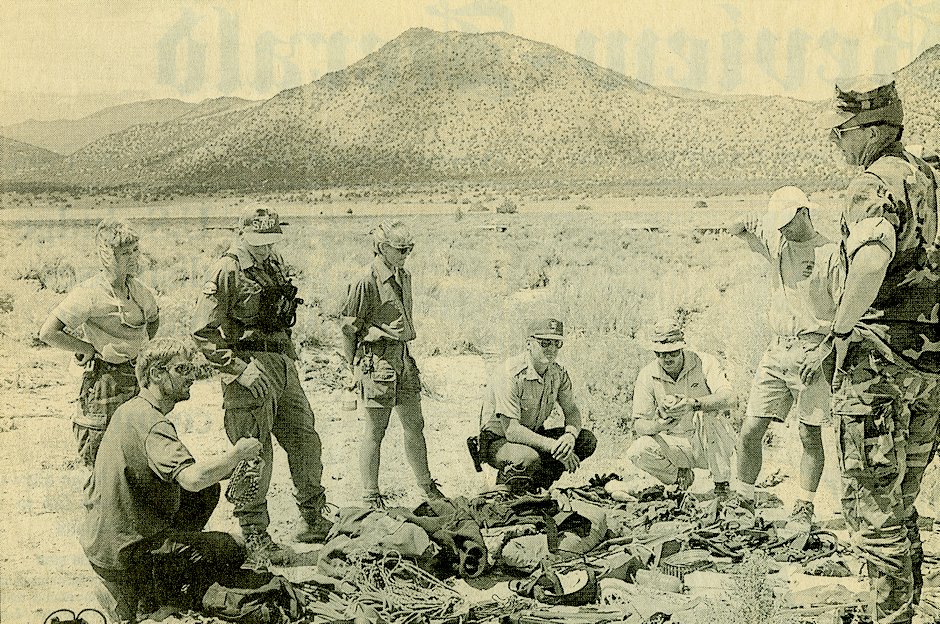
Organized by Shawn Moats, an eleven-agency search and rescue training was conducted in the Bodie Hills on Saturday, August 23, sponsored by the Mono County Sheriff's Department Volunteer Search and Rescue. Agencies that participated and found the mock crash site of an airplane were Mono County SAR, Inyo County Search and Rescue, Mineral County Search and Rescue, Yosemite National Park Search and Rescue, Death valley National Park Search and Rescue, California Highway Patrol Fresno helicopter unit, Naval Air Station Fallon helicopter unit, Mono County Radio Amateur Civil Emergency Service, canine units from WOOF and CARDA, Marine Corp Mountain Warfare Training Center and Brian and Pamela Treadwell on equine. Search managers were Lee Frees, Victor Aquirre and Dean Rosnau.
September
September 1, 1997 97-30R. Lynn Rogers fractured her right ankle while hiking about one hour above the Lundy Canyon trailhead. Victim was evacuated by wheeled litter. Responders were: Rosnau (Ops), Browne, Enyeart, Harvey, Greene, Aguirre, Wright, and Burns.
September 14, 1997 - Mt. Conness exploration and summit ascent, with Greg Enright. Meet at Saddlebag Lake Resort at 9 AM. We seem to get a lot of rescue work in this area, so it will be a fun thing to look it over in the daylight, and have a fine hike too.
From Review-Herald newspaper report by Karen Riggs:
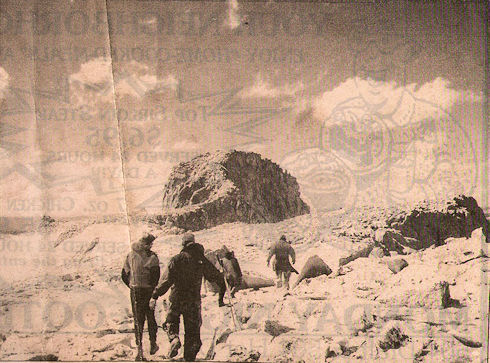
The dragon's back of Mt. Conness offers fine views into Yosemite National Park, as well as to the east. Mono County Search and Rescue recently held a conditioning hike to the top.
New perspectives gained on mountaintops
That which inspires can sometimes be elusive, traveling from work to home and home to work and all over again. It may not he drudgery, but ordinariness.
When this occurs, I say. "get thee to a mountaintop." Exorcise the demons of routine. Purge unclear thought. Shed thy pretenses.
A good uphill slant will do all these things. I don't know why, but putting one foot in front of the other separates thoughts clamoring for attention. What's most important rises and becomes clear.
Each step loosens the ties of ordinary life. Small burdens fall away like so much debris, as muscles work at making the climb.
When the landscape opens up, a similar state of mind pervades. The immensity of the skyline helps bring perspective hack. The rewards are many at the top of a good climb.
*Remember to choose a summit within your ability. Rising above everyday routine is the idea.
Mono County Search and Rescue recently held a conditioning hike to Mt. Conness, elevation 12,590. The idea was not only to prepare physically, but to familiarize the team with an area that had many calls this year, including one death.
Tell someone your plans, prepare for weather and bring a map. K.R.
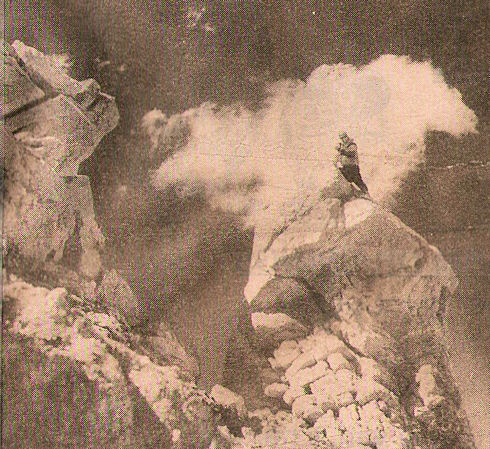
Winn Lewis enjoys boulder-bounding on the way to Mt. Conness
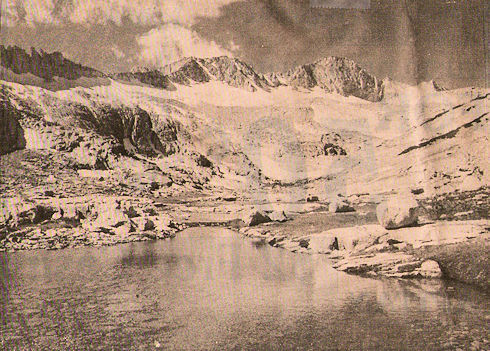
Conness Lake is one of countless beauties which hikers pass on the approach to Mt. Conness
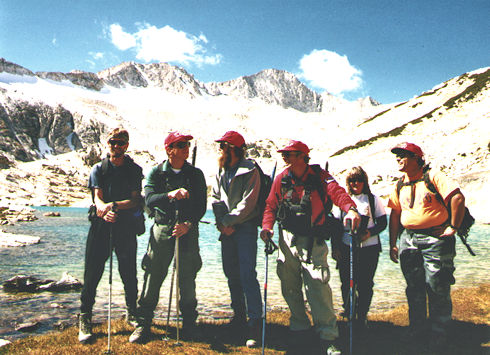
Team ready to go at Conness Lake
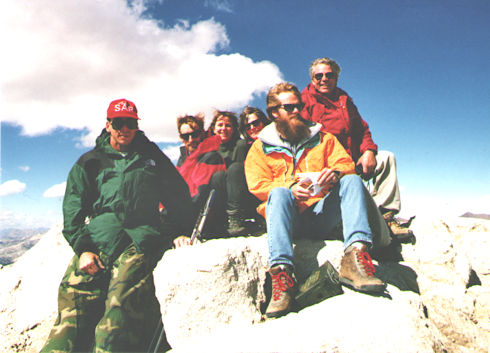
Team on top of Mt. Conness
September 16, 1997 97-31R. A mutual aid request via OES from Sheriff Gary Penson of Esmeralda County to search for a missing woman in Trail Canyon in the Fish Lake Valley area. She was quickly found. Responders were: Harvey, Burns, Tim LeFever, Rosnau, Tracey, and Rousek.
September 18, 1997 97-32R. While working in Owens Gorge (building toilets), Dean Rosnau and Doug Nidever led a rescue of a woman who had fallen about 35 feet and broken her back due to the belay rope being too short and not having a knot at the end. They packaged her up in a litter, hauled her to the rim in Dean's truck, where Medic 3 took charge.
September 21, 1997 97-33R. Alfredo Trejo was missing from his hunting camp in the Lion Point area for two days. Four ground teams and two dog teams were flown in. Dean Rosnau and Natalie Nelson hiked in. Team 3 spotted a small camp fire, which a helo checked out and found the victim, who was dehydrated, hungry, and exhausted. Team 6 hiked him to the helo, and all were flown out. The victim followed two deer then became lost, swam across the river, and eventually started a camp fire with the scope of his deer rifle. Responders were: Lee Frees (ops), White, McBride, Enyeart, Tim LeFever, Nelson, DeGeorge, Rosnau, Karen LeFever, Little, Aguirre, Biederman, Burns, Riggs, and Rousek.
From Review-Herald newspaper report by Karen Riggs:
Lost hunter alerts rescue team using fire built by rifle scope - After spending two nights in the wilderness without provisions or a sleeping bag, a Los Angeles deer hunter alerted search and rescue volunteers to his location by building a fire, using the scope of his rifle as a magnifying glass.
Alfredo Trejo, 59, was separated from his group of coworkers near Lion Point, several miles southwest of Red's Meadow at 8 a.m. Saturday, September 27.
The group, taken in on horses by Red's Meadow Pack Station for their annual deer hunting trip, tried in vain to find Trejo Saturday and Sunday. One member of the party hiked out for help Sunday at noon and notified Mono County, Sheriff's Department.
Trejo said, he had lost track of time Saturday, when he followed two deer and covered more territory than he planned. He also lost his water bottle during the trek.
Becoming extremely thirsty; he went downhill to drink from the San Joaquin River. Even though, he said, he knew approximately where the camp was, his dehydration kept him from recovering ground up the steep, rocky slope.
keeping his wits about him, he built a fire at night for warmth and fired several shots for anyone within hearing distance, but there was no one at the time.
The Mono County Sheriff's Department Search and Rescue Team planned a search to begin early Monday morning. The team summoned a helicopter through the State Office of Emergency Services, as well as volunteers from Radio Amateur Civil Emergency Services (RACES).
One ground team hiked in from Red's Meadow at 6:30 a.m. Monday - an approximately three hour hike, while other team members were airlifted from Mammoth Lakes Airport into the area by a National Guard Blackhawk helicopter out of Sacramento.
As the helicopter passed overhead. Trejo fired a shot to signal the rescue team. While no one in the helicopter heard the shot above the engine noise, a group of hunters across a large ravine did hear it and signaled the helicopter to land.
In the meantime, Trejo partially disassembled his rifle and used the scope, magnifying sunlight to create a fire in the manzanita. His matches had become wet that morning as he traversed the San Joaquin River, wading up to his neck.
"I thought I was going to die," Trejo said later. "Thanks to the search team and thanks to God..."
Search team member Bruce Enyeart saw the column of smoke as he scanned the horizon with binoculars. The helicopter was directed to the area and observed Trejo from the air. He said he had climbed up to an open air where he would be more visible to rescuers.
The Blackhawk was able to find a small landing zone and a ground team reached Trejo at 11:50 a.m.
Suffering from near exhaustion and dehydration, Trejo was helped to the helicopter and returned to Mammoth Lakes Airport and later reunited with his group.
September 22, 1997 - ELT (downed aircraft beacon) training and practice with Greg Enright. Meet at 6 PM in Mammoth at the Rescue 3 parking area behind the Forest Service shop.
September 26, 1997. Mutual aid to Inyo County to search for and do body recovery of hikers un-prepared for an early snowstorm. Responders were: Rosnau, Aguirre, Burns, Kennedy, and Enyeart.
Welcome to Tiffany Taylor and Margina Rhyne, who were accepted as Candidate Members at the September meeting.
October
October 4, 1997 97-34R. An injured hiker was reported at Shadow Lake. USFS ranger Wilderness 26 was on scene, and the victim was picked up by CHP helicopter the next morning and taken to Mammoth Hospital. Responders were: Enyeart and Greene.
October 9, 1997 - Newspaper Article about the Team
From Mammoth Times newspaper article by Christine C. Spiller:
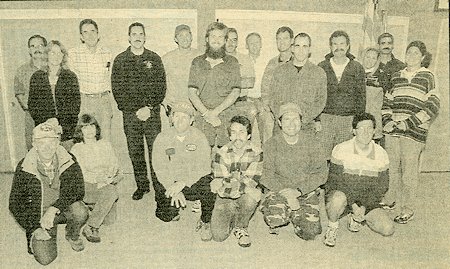
The Mono County Sheriff's 1997 Search and Rescue Team stands at the ready for emergency response
Quick to the Rescue - Being lost or injured in the mountains of the Eastern Sierra can turn a dream vacation tragic. In Mono County, help is quickly on the way, thanks to the all-volunteer Mono County Search and Rescue Team.
All walks of life are represented on Mono's team: a retired doctor, ski patrol members, Sheriff's department employees, contractors and more. "It's a cross section of your community," said Sgt. Boe Turner, the Sheriff department's search and rescue team coordinator.
County Sheriffs are required by California government code to provided search and rescue for missing persons. Search and Rescue teams in most counties are volunteer, but a sworn officer in the Sheriff's department must oversee the program. The cost of the program is borne by the county. However, a California government code section allows the agency to bill the county of residency for the person rescued. The county is able to bill the cost, less the first $100. The amount recovered year to year varies, as rescues and searches involving international visitors and residents outside the state are difficult to collect, Turner explained.
There are about 40 members and candidates on Mono's Search and Rescue team. Candidates are recent additions, not official members of team, Turner said. Candidates complete a year of training, which includes responding to calls with other team members. After the training process, they are voted onto the team.
The county pays for some of the team's gear, but members pay for much of their own gear used on rescues, Turner said. The team's search and rescue operations often overlap county boundaries. Since Devils Postpile National Monument is in Madera County, the team works under a mutual aid agreement with Madera for search-and-rescues in that area.
The team is activated after a call to the Sheriff's dispatch center. Preliminary information is gathered and Turner and Lt. Cole Hampton are notified. "We will make a judgment whether to call out the team," Turner said.
Once the team is activated, members are contacted via a paging system over the county fire frequency. The dispatch center also calls each member on the list and tells them where to report and the nature of the call. The team members respond with a "ready pack" containing all necessary gear.
At the command post, an operations leader is appointed and an action plan is developed. Information about the missing person is gathered from friends or family at the scene. "We look for clues, not people," Turner said of the operation. "The clues will lead us to the person."
For example, team members might ask if the missing person wears glasses. Does he or she smoke or chew gum? What type of shoe is the lost person wearing?
The team starts the search from "a point last seen," Turner said. That means the rescuers track in a wide circle from where the missing person was last seen. Team members use a tracking stick to measure stride of footprints of the person. As the search progresses, Turner said searchers talk to others recreating in the area to find if they have seen the missing individual. After taking all these steps, the team hopefully succeeds in locating the person.
The team has about a 60/40 mix of men and women and ages range from 18 to 50-plus, Turner said. Many members have expertise in such areas as diving or snow rescue.
Turner said the team responds to about 50-60 rescues in a calendar year. Summers are busier, simply because of the volume of people visiting the area, but winters see the team in action frequently with missing backcountry skiers and other rescues.
"In a county where the economy is tourism, we do one heck of a job for the county and its citizens," Turner said.
Team members meet and train the first Tuesday of every month and have two to three additional training sessions a month. The monthly meetings include a critique session of recent missions. Team members analyze what went right and what could have been done better.
New members are always welcome. "We are always looking for anyone in the community interested in helping their community or in learning some new skills," Turner said.
"We couldn't do it without all of these people," he added. Asked about why people decide to become members of the search and rescue team, he responded, "My personal opinion is that it's just people in the community who want to help."
Another part of Turner's job in the Sheriff's department is that of coordinator of emergency services. His salary is funded 50% by the State Office of Emergency Services. Whether it's an avalanche, flood or other natural or man-made disaster, the emergency services division is managed much like a "mini search," only on a bigger scale, he said.
Once a disaster occurs, the emergency staff is activated and the team organizes what help is needed where, and whether help from other agencies affected by the disaster will be necessary. All local agencies such as Caltrans, U.S. Forest Service, the county and others, meet regularly as part of the Unified Command System to prepare for proper coordination in an emergency.
All counties must have emergency services, Turner said. Under the standard emergency management system, the government code is specific about what the counties must do and on the maintenance of response plans. The emergency response plans drawn up are much like checklists. For example, if there is a dam failure, there is a list of items to plan for and to consider.
If a local disaster is declared, a state or federal emergency, that prompts release of funds for assistance and loans for residents whose homes or properties have been damaged.
The county's emergency plans are drawn up and ready. Turner recommended families have their own emergency response plan as well. And he urged parents to know emergency procedures for their children's schools. If a family lives in south county and children go to school in Mammoth Lakes, parents should find out where children would be taken in an emergency situation.
Mono's rescuers include: Victor Aguirre, Dr. Ross Biederman, Robert Browne, Sallee Burns, Steve Case, Mike Clayton, Charlie Curtis, Pete DeGeorge, Jim Endo, Greg Enright, Bruce Enyeart, Debbie and Lee Frees, Tom Frey, Jim Gilbreath, Gary Guenther, Dave Harvey, Scott Hermann, Brent Kennedy, Sam LaLande, Scott LeFever, Tim and Karen LeFever, Win Lewis, Don Little, Kevin Mcbride, Steve McCabe, Shawn Moats, Natalie Nelson, Doug Nidever, Steve O'Connor, Janet and Greg Perry, Karen Riggs, Gus Roderick, Dean Rosnau, Joe Rousek, Chris Simmons, Michelle Tracey, Allan Weidner, Brant White, Lara Wilkinson and Dan Wright.
Support members include: Marty Burgenbauch, Larry Ford, Pete Kirchner, Anne Rousek, Mike Soler, Bob Sollima, Russ Veenker and Fred Weatherly.
This information is provided by Mono County's public information office.
The Swap Meet on October 11 netted $418 for the team, despite an early preview of Winter on that day. Dave Harvey did a great job of organizing it and getting prize contributions for the raffle, including wood carving and ceramic art from Sallee and Gary Burns. Thanks also to those who came to help, and buy and sell tickets, including (at least) Victor Aguirre, Bruce Enyeart, Jim Gilbreath, and Win Lewis.
October 13, 1997 97-35R. Owen Page was overdue in bad weather on a circular hike in Yosemite from the Twin Lakes trailhead. CHP 40 flew the entire planned route, with no sightings. Team 1 of Rosnau and Harvey were flown in to the Mule Pass area, and before landing spotted an arrow stamped in the snow near Mule Pass. They followed tracks, while Dan Wright searched near the trailhead. The victim was found hiking out, in good condition, by Dan Wright, who brought him to the EOC. Responders were: Gilbreath (ops), Harvey, Rosnau, Biederman, Aguirre, Burns, Rousek, and Wright.
From newspaper report:
Hiker found - A 40-year-old hiker from Georgia was found Monday, October 13, 6:15 p.m., in good condition near Barney Lake out of the Upper Twin Lakes at Bridgeport.
Having planned a five-day backpack trip into Yosemite National Park, Owen Page was reported missing by his brother in Oakland who expected to hear from him on Sunday, October 12.
Mono County Sheriff's Department officers found the subject's car at Mono Village, Upper Twin Lakes. A California Highway Patrol helicopter was summoned from Fresno and the Mono County Search and Rescue Team was alerted Monday morning.
From the air, a signal was sighted - an arrow stamped into the snow, with slash marks. The helicopter dropped off one ground crew near the signal at Burro Pass to follow footprints from the arrow. Another ground crew started at the trailhead of Mono Village.
As it turned out, Page had been delayed by snow, according to Lt. Cole Hampton, Mono County Sheriff's Dept. For three days, Page had stayed near Burro Pass, instead of following his planned itinerary.
As the sun began to set Monday evening, the ground crew that started from Mono Village encountered Page approximately five miles from the trailhead.
October 18, 1997 97-36R. John Sands evidently fell from Crystal Crag while climbing alone. His body was found by a hiker, who reported it to the Sheriff. Teams lowered the body from steep slopes, and evacuated by litter. Responders were: Enright (site ops), Gilbreath (base ops), Case, Aguirre, Little, Rosnau, White, Browne, Harvey, Clayton, Tracey, and Greene.
From Review-Herald newspaper report by Jeff Munson:
Hiker dies after fall - The Modesto native and former Gallo wine executive retired five months ago and planned to spend more time in the Sierra - When John Richard Sands retired early this summer as vice president of international marketing for Gallo wines in Modesto, he made it a point to get outdoors as much as he could.
Whether it was biking, running or hiking, Sands told his family that being outdoors was an ideal way to escape the city; a place where he could relax and unwind.
What was to be a six-day outing alone in the Eastern Sierra turned into tragedy when Sands, 50, apparently fell to his death off a cliff along Crystal Crags, south of the Mammoth Lakes Basin.
"He loved the outdoors. He ran a lot and when he retired he tried to get out as much as he could," said Tim Sands of his father.
A hiker walking along the crags found Sands body at about 1:30 p.m. on Saturday afternoon, said Terry Padilla, assistant sheriff of the Mono County Sheriff's Department. On Thursday, Sands telephoned family members to tell them he would return home on Saturday.
Authorities recovered the body on Saturday evening and turned it over to the county coroner for an autopsy. On Monday, chief deputy coroner Steve Maris ruled Sands death as accidental.
According to Maris, Sands fell several hundred feet in rugged terrain, sustaining major injuries to the head, neck and chest. The accident could have occurred sometime on Friday, possibly during the early part of the day since Sands was wearing clothing suitable for day hiking, Maris said.
"We're not sure what happened, whether he made it to the top, or whether he slipped and fell somewhere along the way or whether rocks underneath him gave," Maris said.
Sands had a camera and was wearing a waist-pack, which were recovered. Maris said film in the damaged camera was turned over to the Sheriff's Department for processing.
"We have no reason to believe it was anything other than an accidental death," Maris said. "The film could show us possibly how far he had climbed before he fell."
Family members said Sands was an outgoing man, who hiked and biked in the outdoors as often as he could. When he retired he told family members he wanted to spend as much time in the outdoors as possible.
Earlier this summer Sands took his son, Tim, to Yosemite National Park, where the two climbed Half Dome.
"It was something I will never forget," Sands said.
October 21, 1997 - Mountain Navigation, Part 1, (Map & Compass) with Jim Gilbreath. 6:30 PM at Jim's house at UTM 351815E, 4159207N. Lat 37-34.085N, Lon 118-40.597W. Bring your compass and any 7-1/2 minute map. This is a part of required team training for Candidates, but open to anybody that wants a little more savvy.
October 26, 1997 - Orienteering Test with Jim Gilbreath at his home
November
Elections were held at the November meeting. The Team Officers for 1998 are:
President - Greg Enright
Vice President - Jim Gilbreath
Secretary - Pete DeGeorge
Finance Officer - Victor Aguirre
Equipment Officer - Dave Harvey
Training Officer - Dean Rosnau
Sallee Burns will be getting a new search partner soon. A German Shepherd puppy named Slider. He may put in an appearance at the December meeting. Poor Trapper - he has only a few more days of peace at home until he has to begin helping to train the young whippersnapper.
November 2-6, 1997 - National Avalanche School at Tahoe
November 22, 1997 - Gorge Familiarization and Climbing, with Dean Rosnau. Meet at Hwy 395 and Gorge Road near the bottom of Sherwin Grade at 8 AM. We will explore the access routes and parking areas for the Lower, Middle, and Upper Gorge climbing areas, descend into the Gorge, learn about sport climbing techniques, be instructed in climbing, belaying, lowering, rescue scenarios, techniques, and war stories. Bring your ready pack and climbing gear if you have it, otherwise we'll get harnesses and helmets, etc. from the rescue vans. Dress with layers for everything from sun to cold wind. This is for EVERYBODY, even if you're already an experienced Gorge Rat.
November 23, 1997 - GPS training and exercise with Jim Gilbreath. Meet at Smokey Bear Flat at 2 PM. We will use the team's various models of GPS receivers to determine current location, bearing and distance, map coordinates, solve navigation problems, and find the treasure. BRING YOUR COMPASS, a notepad, and an Old Mammoth map if you have one.
Welcome to new Candidate Members Chuck Bauss, Bill Greene, Ilana Levin, Jay Johnson, and David Melkonian, who were accepted at the November meeting.
Joe Rousek, Dean Rosnau, and Lee Frees are back from a week of National Avalanche School in Tahoe, and spouting all sorts of showy-snowy technical jargon like sublimation and metamorphism water vapor.
There were no operations in November.
December
December 7, 1997 97-37R. About 1430 Pete Duckett separated from his group of Mammoth snowmobilers and went down the steep north side of Bald Mountain and got stuck in Clark Canyon. Victor Aguirre and Dean Rosnau were taken up via Sheriff's snowcat and searched downhill on snowshoes, while Joe Rousek and Bill Greene searched uphill. Both teams heard the victim yelling for help, who was in pretty good condition when Dean and Victor got to him. Both teams assisted the victim to hike up to the snowcat. Responders were: Harvey (ops), Rosnau, Bauss, White, Enyeart, Greene, Aguirre, DeGeorge, Rousek, Little, Browne, and Johnson.
December 12, 1997 - Lake Ice Rescue Training and Practice with Dean Rosnau, at Twin Lakes (Mammoth). Meet at 4:30 PM sharp at Tamarack parking area. Even if you don't really want to put on a Stern suit and get in the water, come anyway, as shore handlers are needed, and you can learn how this very important type of rescue is done. Attendees were: Enright, Endo, Rosnau, DeGeorge, Lewis, Harvey, Bauss, Aguirre, Tracey, Greene, Browne, Nelson, and Biederman. The new line gun was also tested with some participants firing the system. More training with that will come later.
December 16, 1997 97-38R. Alan Screen was last seen on his snowboard going out of bounds off the west side of Hemlock ridge about 1300. Team 1 of Dave Harvey, Brant White, and Bill Greene started from Reds Lake to cut track, while Team 2 of Kevin McBride and Pete DeGeorge followed track from Hemlock Ridge. Two Ski Patrollers with snowmobile and bullhorn found the exhausted victim near Pumice Flat at 1905 and evacuated him via snowmobile. MMSA Snowcat picked up our teams at Pumice Flat. Mammoth ham repeater used very effectively for communications. Nice to have at least one ham per team. Responders were: Rosnau (ops), Greene, Harvey, White, DeGeorge, McBride, Aguirre, Newman, and LeFever.
From Review-Herald newspaper report by Karen Riggs:
Mono Search and Rescue Honors Two Members
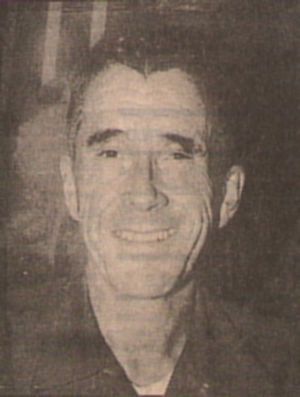
Jim Gilbreath
Mono County Search and Rescue member Jim Gilbreath calls himself "the gadget guy." His peers recently named him 1997 Search and Rescue Team Member of the Year, and Robert Browne was voted Candidate of the Year.
Gilbreath's extensive background in electronics, computers, navigation and mountaineering make his contributions to the SAR Team invaluable. Gilbreath was an engineer for the San Diego U.S. Navy Laboratory for 33 years, was science adviser for the Commander of the Pacific Fleet and installed the first digital computer aboard a Navy ship in 1960. He was also involved with the introduction of the Global Positioning System (GPS) a navigational tool that uses satellites to pinpoint geographic locations.
As a Sierra Club mountaineering leader for 22 years, Gilbreath was intimately familiar with the Sierra Nevada before retiring and moving from San Diego to Mono County.
He credits Doug Magee with helping him become involved in SAR. "I went to a meeting and decided 'This makes good sense,'" Gilbreath said. 'It's a great thing to do. helping someone who really needs it."
Of the many searches he has been on, two stand out in his mind. Three years ago an elementary school principal from the Central Valley survived six days without food, before SAR team members found him with numerous broken bones after a fall.
Jerry Dragoo had left the Dorothy Lake area, with the purpose of leaving a small memorial to his son on one of the peaks. His plans were indefinite, and it was four or five days before he was reported missing.
Gilbreath said organizing a search is like putting a puzzle together. Information is gathered from many sources "to decide the best places to concentrate your resources."
Since Dragoo's son had been killed in a car accident, "the possibility of suicide had to be considered. In actuality, he had a severe fall, but had been able to crawl to water to keep himself dehydrated.
The search mobilized 100 people from 13 agencies including 84 sorties flown by the Air National Guard helicopter crew. Ultimately it was a dog team which located him - he and the dog team heard each other.
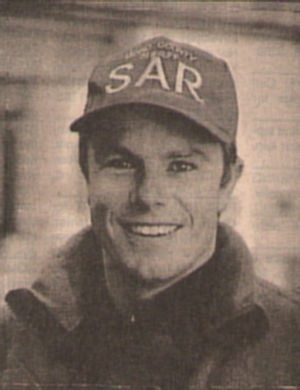
Robert Browne
Another search which had a happy ending was for a young man who consequently became a Search and Rescue member. After being stuck on a ledge in the White Mountains during a snow storm for three days, he was located by a heat seeking helicopter.
Robert Browne, candidate of the year, also recalls that search. "I was trying to do everything I could to get out in the field," he said, but worked as a support person for base operations instead. Although he wanted to be out searching, he said he learned a great deal about the Global Positioning System from Jim Gilbreath and search organization in general.
Browne has been involved with Mono County Search and Rescue for about 2 1/2 years and said he "can't get enough of it."
"SAR is a good opportunity for people to serve the public," Browne said. "Anyone who is interested should realize that there is a need, as well as it being a commitment."
But, "it's not easy to balance a work life that allows one to go on searches." according to Browne. Summer is usually the busiest time. The team averages 90 team events, of which about 40 are actual searches or rescues.
All members are volunteers and do not receive compensation of any kind. Currently, the team has 19 rescue members and 27 candidates who must undergo at least one year of training in techniques for search, high and low angle rock rescue, mountain travel, navigation, tracking, first aid and CPR in order to be considered for Rescue Member status. They also train in swift water, avalanche, ice rescue, ice climbing, steep snow, helicopter safety, snowmobile operation and diving in open water and under ice.
The Mono County Sheriff Search and Rescue Team originated in June Lake in 1966, originally called the June Lake Mountain Rescue Team.
Welcome to new Candidate Member Jeremy Newman, who was accepted at the December meeting.
Sallee Burns brought her new search trainee to the December meeting. His name is Slider, and he is 11 weeks old, and wonderful.